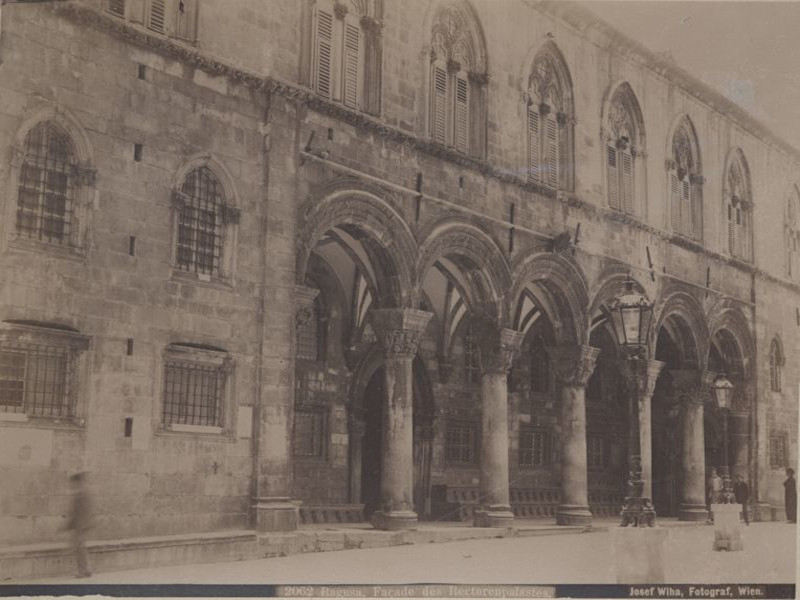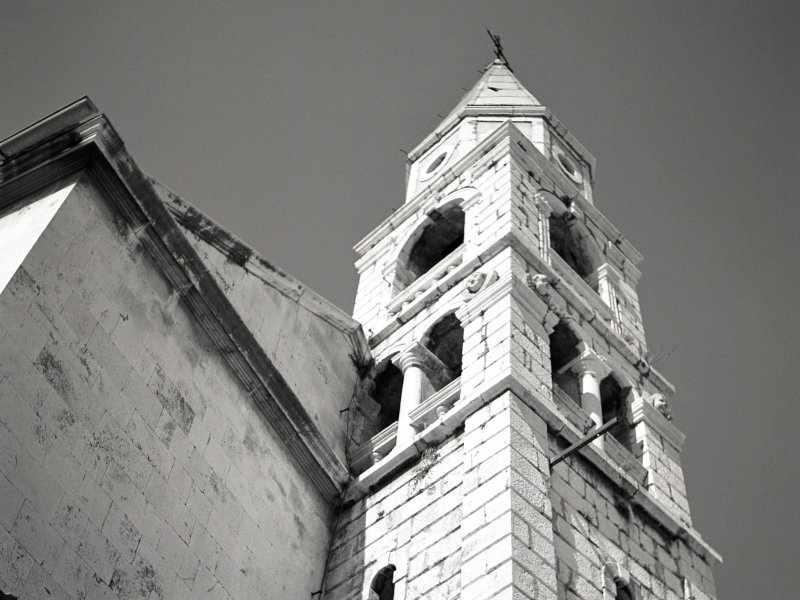AdriArchCult
Architectural Culture of the Early Modern Eastern Adriatic
About
Between the 15th and 18th centuries, the eastern Adriatic – an area partitioned between the Republics of Venice and Dubrovnik, the Kingdom of Hungary-Croatia, and the Habsburg and Ottoman Empires – was politically transformed into a vast archipelago, including the mainland coastal towns which were divided from the hinterland. This process triggered the formation of a fluctuating and ‘floating’ architectural market, which functioned within a multilingual and multiconfessional context.
The aim of the AdriArchCult project is an overall study of the architectural culture of the region, examining its political, religious, cognitive, and practical spheres, and thus overcoming the divisions of historiographies in different languages as well as traditional approaches based on the national or centre/periphery paradigm. The result will be an innovative and dynamic vision of the architectural production of a region that connects the various faces of European culture.
News
Andrea Missagia, PhD candidate affiliated with the project, defended his dissertation ‘Oreficerie veneziane e smalti traslucidi tra XIV e XV secolo’, made at Ca’ Foscari under the supervision of Michela Agazzi, Simone Piazza, Walter Cupperi, and Carlo Cavalli.
Daniele Pelosi, PhD candidate affiliated with the project, defended his dissertation ‘Identità e contesti nella committenza del cardinale di Senigallia Marco Vigerio (1505-1516)’, made in cotutelle between Ca’ Foscari of Venice (supervisors Valentina Sapienza and Jasenka Gudelj) and the University of Amsterdam (supervisor (Arnold Witte).
Jasenka Gudelj, Elisabetta Molteni, Alberto Pérez Negrete, Chiara Squarcina, Elisabetta Concina, Giuliana Mazzi, and Federico Bulfone Gransinigh presented the new edition of Ennio Concina’s book ‘La Macchina Territoriale. La progettazione della difesa nel Cinquecento veneto’ edited by Alberto Pérez Negrete and with introductory studies by Jasenka Gudelj and Elisabetta Molteni at the Doge’s Palace in Venice.
Previous news
2021-2025
2025
- 16/04/2025
Jasenka Gudelj, Elisabetta Molteni, Alberto Pérez Negrete, Chiara Squarcina, Elisabetta Concina, Giuliana Mazzi, and Federico Bulfone Gransinigh presented the new edition of Ennio Concina’s book ‘La Macchina Territoriale. La progettazione della difesa nel Cinquecento veneto’ edited by Alberto Pérez Negrete and with introductory studies by Jasenka Gudelj and Elisabetta Molteni at the Doge’s Palace in Venice. - 8/04/2025
Jasenka Gudelj, Katja Borak, and Joško Bracanović presented the book ‘Zbirka Hvarskog povijesnog kazališta: Katalog’ [Collection of the Historical Theatre of Hvar: Catalogue] for which PI Gudelj wrote the introductory study. - 3/02/2025
Jasenka Gudelj, Tonija Andrić, Joško Belamarić, and the author Petar Strunje presented the book ‘Splitski lazaret i trgovačka skala’ [The Venetian Lazaretto and Free Port of Split], FF Press, Zagreb, 2022, at the Faculty of Humanities and Social Sciences in Split.
|
|
Poster 3/02/2025 [HRV] | 342 KB |
2024
- 15/12/2024
Jasenka Gudelj, Ana Marinković, Ivana Mance Cipek, Ljerka Dulibić, Darija Alujević, and Tamara Bjažić Klarin presented the conference proceedings of the IX Dani Cvita Fiskovića ‘Žene u/o umjetnosti’ [Women in/on the Arts], FF Press, Zagreb, 2024, at the ArtZagreb festival held at the Croatian Association of Artists (HDLU) in Zagreb. - 12/07/2024
Team member Beatrice Tanzi defended her PhD thesis ‘La visita apostolica di Agostino Valier (1579). Una ricerca sulle emergenze architettoniche e artistiche rilevate in Dalmazia dopo il Concilio di Trento’ at Ca' Foscari University of Venice (supervised by Jasenka Gudelj) and received summa cum laude honours. - 12/07/2024
Team member Giuseppe Andolina defended his PhD thesis ‘Giovanni Dalmata e le rotte adriatiche della scultura del Quattrocento’ at Ca' Foscari University of Venice (supervised by Jasenka Gudelj) and received summa cum laude honours. - 24/04/2024
Team member Karla Papeš has defended her PhD thesis ‘Military Architecture between Theory and Practice in the Early Modern Eastern Adriatic’ in Venice, made in cotutelle between Ca' Foscari University of Venice (supervisor Jasenka Gudelj) and the University of Zagreb (supervisor Bernardina Petrović), receiving summa cum laude honours. - 3-7/06/2024
PI Jasenka Gudelj and team members Cristiano Guarneri and Petar Strunje participated in the second part of the ‘Visualizing Cities Summer Institute: Exhibiting Hidden Histories: Bringing Art History Projects to Publics through Digital Exhibitions and XR’ at the Venice International University on San Servolo offered by the Duke University and supported by the Getty Foundation.
2023
- 16/09/2023
PI Jasenka Gudelj talked about her ERC experience at the ERC promotion event organised by Scientific Officer Aneta Krzemien Barkley during the 10th International Conference on the Histories of Media Art, Science and Technology at Ca' Foscari University of Venice. - 13/09/2023
PI Jasenka Gudelj participated in the seminar ‘Textuality and Diversity: A Literary History of Europe and its Global Connections, 1529-1683’ of the ERC project TextDiveGlobal (Queen Mary University of London) held at the University of Rijeka (Croatia) with the talk ‘Discussiones Peripateticae: Architectural Culture of Frane Petris/Francesco Patrizi of Cres.’ - 30/08-5/09/2023
PhD candidate Karla Papeš has participated in the ‘65th Course on Palladian Architecture Palladio and Venice: Politics and Architecture’ offered by the Palladio Museum. - 5-16/06/2023
PI Jasenka Gudelj and team members Cristiano Guarneri and Petar Strunje participated in the ‘Visualizing Cities Summer Institute: Exhibiting Hidden Histories: Bringing Art History Projects to Publics through Digital Exhibitions and XR’ at the Venice International University on San Servolo offered by the Duke University and supported by the Getty Foundation.
2021
- 2/06/2021
Jasenka Gudelj presented the AdriArchCult project at the roundtable on ‘Experiences Finding Funding’ organised within the 6th international meeting of the European Architectural History Network, hosted by the Edinburgh College of Art and held online.
Main research domains
1) Territorialization
Political presence on the territory in question is analysed through the most common medium of dividing spaces and creating boundaries: architectural production.
Research of the specific symbolic values and functional needs of different buildings will contribute to an understanding of architecture as a strategy of political presence.
The research will analyse the material presence of the buildings and the processes of negotiation between local communities and various ruling powers, in order to define the strategies of differentiation applied by these powers.
2) Religious sphere
The dynamic multi-confessional sphere was comprised of an existing dialogue with Orthodox Christians and Jews, new daily contact with Islam through the presence of the Ottomans, and echoes of the Reformation. This religious diversity triggered oscillations between coexistence, and conflict. The Catholic revival and confessionalisation of the powers generated intense building activities.
The main focus is to understand how the cohabitation of different powers and their interests, supported by the Counter-Reformation, as well as the different religious needs of commissioners, resulted in complex architectural outcomes.
3) Peripatetic of knowledge on architecture
The intellectual sphere of architecture in the eastern Adriatic archipelago was shaped by Europe-wide processes, in which it actively participated. Supported by the pan-European revival of antiquity, the architectural production in the area was also largely shaped by intense intellectual activity. The circulation of knowledge for both patrons and artists depended on the mobility of ideas, expressed visually and verbally.
Therefore, the role of the printed book market in shaping the dialogue between professionals and patrons within the multilingual reality of the Adriatic rim will be explored.
4) Architectural practice
Construction sites along the eastern Adriatic Coast represented a wide network of a shared specialised workforce, materials, practices, and technology, as well as construction site organisation, within which a balanced market for architectural goods was formed.
The main objective is to reveal and define agents of exchange and commerce, as well as the system of exploitation of goods, in order to understand the internal mechanisms of architectural production in the eastern Adriatic.




